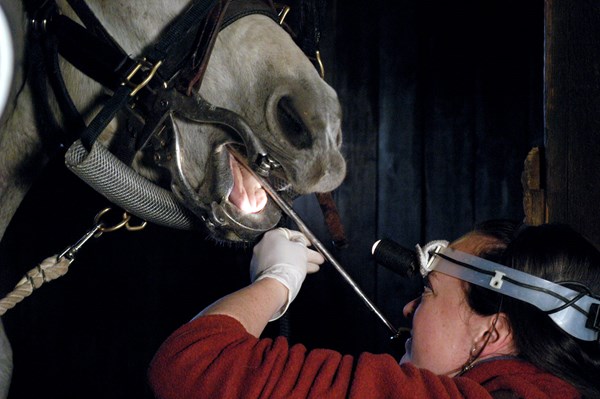 Credit: Dusty Perin
Credit: Dusty PerinThere are many factors that contribute to what a veterinarian should charge for his or her services. Does a vet have a unique skill in a particular service? Is there a high level of loyalty to a practice, or do the clients pick a vet based on availability or convenience? Are clients so used to price shopping on the web trying to find the cheapest products online that they begin price-shopping veterinary services? Is there an overabundance of vets in one area who are trying to compete over pricing? With all of these challenges, it is never easy trying to figure out the right prices to charge. There are lessons to be learned from other industries to help guide us on pricing decisions.
Pricing of products and services has become a science in many industries as companies strive to maximize what clients are willing to pay. Until the mid-1980s, most businesses managed profitability by cutting costs and hoped that the market would buy whatever they were selling at the current market price. A new school of thought introduced “dynamic pricing,” which argued that time should be considered part of the value of an item.
A great example of this are the fees that ticket scalpers charge for events. When there is high demand before a baseball game or concert, ticket prices will rise. If there are tickets left over once the event begins, the price will decline quickly.
Another component in the price of a product or service is realized when consumers pay a different price based upon that product or service’s availability. Airline and hotel prices are obvious examples of this. If space is limited and demand is high, the prices will rise for those services.
Smart companies with access to sophisticated analytical tools are able to use data to adjust pricing automatically. They are able to sell the same amount of product or services while charging more, depending on the variables present. Have you ever tried to book a flight and noticed that the more you search for the flight you want, the more the price goes up over time? The airline systems note the increased activity and raise the price, assuming there is greater demand for the flight.
Amazon changes its prices 2.5 million times per day as its systems adjust prices based upon demand. Have you noticed the new electronic pricing systems at some Walmarts? A friend of mine commented how it must save [the company] time and effort when they change prices over the year, when in fact the company can use these signs several times daily to adjust prices based upon demand.
Is there anything an equine veterinary practice can do to realize the benefits of dynamic pricing? After all, we are selling medical care, not books or hotel rooms. Doesn’t it seem unethical to charge more when a horse is in distress and needs our services right away? Are there opportunities to charge more for certain services, or are we leaving hard-earned money on the table?
Let’s review how veterinarians set their prices; then we’ll discuss what pricing strategies are available for veterinary businesses to maximize revenue ethically.
The Basis of Veterinary Pricing
Most veterinary businesses determine prices based on one or both of the following factors: what the competition charges, or an annual price increase by a set percentage. I’m sure we are all guilty of getting someone to be a secret shopper who calls up the competition to see what they charge for certain items.
There are certain shopped items such as vaccines and call fees that we need to price competitively. Unfortunately, many clients often do not appreciate the difference between these items and balk at paying more for something that appears identical.
The other common pricing tactic is to raise prices a certain percentage point at the beginning of the year. This seems like a good idea to keep ahead of inflation and help offset the price increases we face in a number of categories, including suppliers, fuel, labor, insurance and equipment. But is it a good idea?
Is the rate we use appropriate? Should all items be priced the same across the board, or are there opportunities to price some services differently? Has the market reached a saturation point so it can’t afford a price increase?
Let’s examine some other pricing tactics used in other industries to see if they are appropriate for our business.
Freemium Model
This model is common with software or app providers that offer a free, but limited, software in addition to a full-featured, paid version. This is an effective tactic if the cost of the service is minimal or non-existent for the number of users. Once basic fixed costs are taken into consideration for an app, it doesn’t cost any more to have 1,000 or 100,000 users.
Fixed costs are those that are needed to turn on the lights or start the truck, such as rent, electricity, insurance, etc. A veterinarian can’t really offer this pricing model since we are limited by time. We can only look at so many horses in a day, so if a portion of the day is filled with free or discounted services, we have little time for full-paying customers.
However, in reality, this pricing model exists in equine veterinary medicine. Just ask racetrack vets who offer free physical and lameness exams in the hopes of making their money selling medications and treating horses. This breed of veterinarian is scrambling while trying to charge for professional services as clients buy medications online or price-shop for the cheapest vet to treat their horses. This is not a good situation for a veterinarian.
Loss Leaders
Grocery stores are the biggest sellers of products as loss leaders. This model is based upon selling popular items at a loss or near a loss in the hope that the customer will buy other, more profitable items. Grocers will sell staples such as milk and bread at a near-cost price hoping that as you walk through the store to reach the far corners where milk and bread always seem to be, you will pick up cereal or coffee that is priced at a higher margin.
Veterinarians do this to a certain degree when we price vaccines or call fees at the same prices as our competitors. We don’t charge as much as we should for these costly items, but it gets us in the door to offer full-priced professional services. It’s a suitable option if the amount of loss-leading services are limited.
Penetration Pricing
Many newer vets are trying to establish their businesses by setting all of their prices very low in the hope of attracting clientele. The ultimate goal is to raise the prices once they have established clients. Unfortunately, this rarely happens since the clients are usually attracted by the prices and once those prices go up, the clients flee to the next cheap vet.
This is never a good option. Imagine if Walmart tried to price its products like Nordstrom. I don’t think the chain would be as popular as it is now.
Variable Pricing
Depending on where one lives in North America, veterinarians usually have busy and slow seasons. I’m among the many vets who have always wished that they could smooth out the peaks and valleys of these seasons so we aren’t so busy in the spring and summer and so slow over the winter. Unfortunately, our patients are not sympathetic to our plight, since they want to show in the summer and most of their vaccines are needed then, too.
The one thing we can change is dentistry, since it is not season-dependent for the average horse. Some vets offer a seasonal discount in which they reduce the price of dentistry by 10-20% if they can do the procedures during a slower period of the year. There are numerous advantages to doing this. It helps increase cash flow during the slow season, and vets and staff are less busy and at less risk of burning out if they can move some services to the slow season. It also frees up time for vets to perform other services that are popular during the busy time of year.
Although it seems like we are reducing our prices, we are actually making a better decision financially by improving our cash flow and increasing opportunity to provide higher-priced services when demand is high.
The risk of this is offering too great a discount. If 20% is attractive to a client, 10% might be equally effective. If you are trying this for the first time, try less discounting (10% instead of 20%) to see how effective the promotion is. You can always increase the discount the next year, but it is harder to lower the savings.
Margin Pricing
Ideally, a business knows what its costs are before offering a product and service; then it can set prices based on how much profit it wants to make. The challenge is figuring out what things cost.
It is easier for products, since we know the price when we purchase them. Once we add a holding amount to account for administrative costs, breakage and expired product, we can add a markup that is automatically adjusted by the practice manager software.
It is harder to price the costs of services since there are so many variables in what vets do. If all lameness appointments were 20 minutes long and involved a PD block, it would be much easier to determine what it costs us to perform the service. Instead, it is a wise move to examine the services you offer that are not price-shopped.
For example, I have yet to have a client ask me how much I charge to rectal a colicky horse, tube a horse with choke or perform a sacroiliac ultrasound. The key is to find services that are rarely performed, require special skills, or that you or your practice are known for offering.
Without detailed data analysis it is hard to determine just what the prices should be, so it becomes a process of trial and error. For example, if you charge $200 for a limb ultrasound and never have pushback on the price, try raising the price to $220. That is a 10% increase, which is higher than the average annual price increase, but it is unlikely to be questioned. This is an effective strategy, knowing that some items can’t be charged at a realistic price (such as vaccinations), yet other services have a lot of price elasticity.
Take-Home Message
Every business has its own challenges and unique situations, so trying to use just one pricing model is rarely enough. Often businesses need to examine the competitive nature of the local veterinary industry, the price consciousness of their clients, the loyalty of clients and the unique value offered them. The more a business’ loyalty and unique value are recognized by its clients, the more opportunities there are to adjust prices.
This is similar to the pricing models used in other industries similar to your veterinary business. They have an element of time or space sensitivity, as well as high demand, that enable them (and you) to adjust prices more readily.
Most veterinary practices run a tight ship, so there is little to trim from expenses. Being able to adjust prices effectively and fairly is a great way to increase profitability without preying on vulnerable clients or compromising care. Even without the data processing power of an airline or Amazon, veterinarians can still find pricing opportunities to improve the value of their businesses.

![[Aggregator] Downloaded image for imported item #18965](https://s3.amazonaws.com/wp-s3-equimanagement.com/wp-content/uploads/2025/11/26161444/EDCC-Unbranded-4-scaled-2-768x491.jpeg)
![[Aggregator] Downloaded image for imported item #18808](https://s3.amazonaws.com/wp-s3-equimanagement.com/wp-content/uploads/2025/11/06141153/EDCC-Unbranded-17-scaled-1-768x512.jpg)

